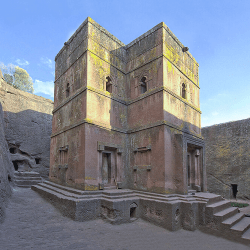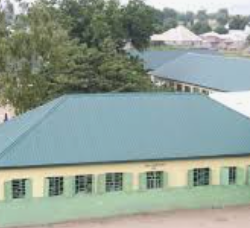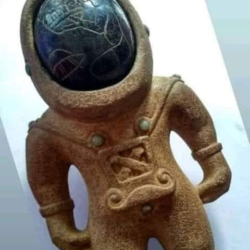Astonishing One-of-a-Kind Stone Capital with Menorah, Lasting 1,500 Years Old, Unearthed in Jerusalem
One-of-a-kind stone capital with menorah – Unearthed near Jerusalem, this 1,500-year-old artifact offers rare insight into Jewish history and architecture.
This remarkable discovery of a unique 1,500-year-old stone capital adorned with an eight-branched menorah offers fascinating insights into ancient Jewish and Roman interactions in the Jerusalem area. Here are the key takeaways from the announcement:
1. Unprecedented Archaeological Find
- The limestone capital, discovered in 2020 near Jerusalem’s entrance, is the only one of its kind ever found, with no parallels in archaeological records.
- It was unearthed in a Byzantine-era building (6th–7th century CE) but was originally carved in the late Roman period (2nd–4th century CE) and later reused.
2. The Enigmatic Eight-Branched Menorah
- Unlike typical Corinthian capitals (which feature floral designs), this one bears an eight-branched menorah—a striking deviation from the seven-branched Temple menorah commonly seen in synagogues (e.g., Capernaum, Caesarea).
- The lower section has eight leaves, possibly symbolizing the Hanukkah menorah or an artistic misinterpretation of a floral motif.
3. A Historical Mystery: Jewish or Roman Origins?
- Found in a settlement likely inhabited by retired Roman soldiers, the presence of a Jewish symbol raises questions:
- Was it repurposed from a destroyed Jewish site after the Bar Kokhba revolt (132–136 CE), which devastated Judean Jewish communities?
- Or was it carved by a non-Jewish artisan unfamiliar with Jewish iconography, accidentally resembling a menorah?
- Dr. Yuval Baruch suggests it may have been brought from elsewhere as construction material, reflecting the upheaval of Jewish life in the region post-revolt.
4. Symbolic and National Significance
- The menorah became a defining Jewish symbol after the Second Temple’s destruction (70 CE), making this find a rare testament to Jewish presence—or cultural influence—in the Jerusalem hills during Roman times.
- Israeli Heritage Minister Amichai Eliyahu emphasized its role in affirming the unbroken Jewish connection to Jerusalem and Israel over millennia.
5. Public Display for Independence Day
- The capital will debut at the Jay and Jeanie Schottenstein National Campus for the Archaeology of Israel in Jerusalem, aligning with Israel’s Independence Day celebrations.
- Eli Escusido of the Israel Antiquities Authority highlighted the timing as symbolic: “The connection to roots and values is the source of our strength.”
Why This Matters
This artifact bridges Roman, Byzantine, and Jewish history, offering clues about cultural exchange, survival, and identity in antiquity. Whether it was a Jewish relic reused by Romans or a coincidental design, its discovery underscores Jerusalem’s layered past and the enduring legacy of Jewish heritage in the land.
For those visiting Jerusalem, this is a once-in-a-lifetime chance to witness a truly unique piece of history.

A discovery that bridges ancient history with modern identity has emerged from the archaeological layers beneath Jerusalem. A one-of-a-kind stone capital with a menorah, believed to be over 1,500 years old, has been unveiled by the Israel Antiquities Authority (IAA). Discovered in 2020 during excavations preceding a major infrastructure project, this limestone capital has undergone meticulous analysis by scholars from both the IAA and the Hebrew University.

Now, in celebration of Israel’s Independence Day, this remarkable artifact will be revealed to the public for the first time at the Jay and Jeanie Schottenstein National Campus for the Archaeology of Israel in Jerusalem.
This revelation holds profound cultural and historical significance—not only due to its exceptional craftsmanship and symbolic decoration but also because it tells a unique story about Jewish life and continuity in post-Temple Judea.
Architectural Significance of the Capital
In classical architecture, a capital is the decorative uppermost part of a column, often bearing weight and connecting the column to the horizontal elements it supports. Traditionally adorned with floral or geometric patterns, capitals served both structural and ornamental purposes.
However, this capital breaks convention. Instead of the typical Corinthian leaf or acanthus motif, this one features an eight-branched candelabrum, akin to the Jewish menorah—a feature never before documented in architectural capitals of this era or region.
Unveiling the Menorah Design
The eight-branched menorah depicted on each side of the capital’s upper section is unlike the more commonly found seven-branched menorahs, historically associated with the Temple in Jerusalem. According to Dr. Orit Peleg-Barkat, the artisan might have aimed to carve a traditional floral motif but ended up crafting a lamp-like symbol due to unfamiliarity with standard architectural norms.
Whether by intention or mistake, the result is a symbol steeped in Jewish identity and cultural resonance. Each side of the capital also features eight carved leaves on its lower section—mirroring the symmetry of the upper menorah design and perhaps symbolizing eternal light or divine presence.
The Concept of Secondary Use in Archaeology
The capital was found upside-down, embedded in the floor of a Byzantine-era building, suggesting secondary use—a term used in archaeology to describe the repurposing of architectural elements from one structure to another. This practice was common during times of transition, war, or rebuilding.
Experts believe the capital may have originally adorned a public or religious building during the late Roman period (2nd–4th century CE) and was later reused in a more modest structure, likely by those unaware of its symbolic value.
The Capital’s Original Context and Relocation
From its artistic style and carving quality, archaeologists hypothesize that the capital may have once stood in a Romanized settlement inhabited by army retirees, possibly adorning a prominent civic structure. Its relocation to a less significant building hints at the cultural and demographic shifts in the area following the Bar Kokhba revolt, which devastated Jewish life in Judea.
Experts Weigh In on the Find
Dr. Uzi Ad and Anna Eirich of the IAA express amazement at finding such a Jewish symbol in a Romanized environment, calling it a true historical conundrum. Meanwhile, Dr. Yuval Baruch underscores the rarity of this discovery, especially considering the historical decline of Jewish presence in this region post-revolt.
Dr. Peleg-Barkat’s interpretation adds a layer of complexity—proposing that this may not have been an intentional menorah, but rather a symbol born out of artistic improvisation, blurring the lines between religious symbolism and decorative experimentation.
The Capital and Jewish Symbolism
The menorah has long been a sacred emblem of Jewish faith, representing enlightenment, divine wisdom, and continuity. Carved onto a stone capital—an architectural component typically reserved for structural utility—this symbol takes on an even deeper resonance. Following the Second Temple’s destruction in 70 CE, the menorah increasingly emerged as a central motif in Jewish art, coinage, and synagogue decoration.
That this particular capital showcases an eight-branched menorah, rather than the traditional seven-branched version associated with the Temple, is both unusual and symbolic. Some scholars suggest it might unintentionally resemble the Hanukkiah, used during Hanukkah, which has eight branches. However, no direct association with this festival has been confirmed.
The presence of this symbol in a location not previously linked to a synagogue or known Jewish community is a powerful testament to the enduring cultural identity of Jews in ancient Judea. It underscores the possibility of either Jewish artisans contributing to public architecture or the reuse of materials from once-prominent Jewish structures.
Post-Bar Kokhba Revolt Jewish Presence in Judea
The Bar Kokhba Revolt (132–136 CE) marked one of the most catastrophic events for Jewish settlements in the Judean Hills. Following the Roman victory, large swathes of Judea were razed, and Jewish political and religious life was profoundly disrupted. Many settlements were abandoned or repurposed by non-Jewish populations.
This context magnifies the significance of the capital. If it originated from a Jewish community destroyed during the revolt, its survival and reuse centuries later reflect the layered history of the region and the relics of resilience left behind. It could be a rare remnant of a Jewish presence that persisted, in some form, despite the official Roman suppression.
Menorah Symbolism Through the Ages
From ancient carvings on the Arch of Titus in Rome to contemporary depictions on the Israeli national emblem, the menorah has remained a timeless symbol of Jewish survival and divine illumination. Throughout history, menorahs have appeared in many forms—on synagogue floors, burial tombs, oil lamps, and religious manuscripts.
This newly unveiled capital contributes a unique variation to that lineage. Its eight-branched design, set within a public architectural element, challenges previous assumptions about how and where Jewish symbols were used. It speaks to a diverse visual culture where spiritual symbols might transcend traditional boundaries and find their way into both religious and secular spaces.
The Role of the Israel Antiquities Authority
The Israel Antiquities Authority (IAA) has been instrumental in preserving, researching, and sharing this incredible discovery. Through its collaboration with the Hebrew University of Jerusalem, the IAA has ensured the capital underwent thorough scientific examination, including material analysis and comparative architectural studies.
More importantly, the IAA has championed public accessibility, planning to display this capital at the Jay and Jeanie Schottenstein National Campus for the Archaeology of Israel in Jerusalem. This initiative aligns with their mission to promote cultural heritage and foster national and historical awareness among Israelis and visitors alike.
The Jay and Jeanie Schottenstein National Campus
Located in Jerusalem, this state-of-the-art archaeological center serves as a beacon for cultural heritage, offering the public a direct view into Israel’s ancient past. The debut of the one-of-a-kind stone capital with menorah coincides with Independence Day celebrations, reinforcing the connection between Israel’s ancient legacy and its modern sovereignty.
Visitors can expect a guided, immersive experience, complete with exhibits that contextualize the capital within broader historical narratives. This presentation not only enhances public knowledge but also nurtures a deeper appreciation for Jewish continuity and archaeological science.
Public Reactions and Cultural Impact
The announcement of the find has sparked widespread interest, with Israeli officials and scholars praising its cultural and national significance. Minister of Heritage, MK Rabbi Amichai Eliyahu, emphasized the capital as a symbolic link between ancient Jewish identity and modern Israeli statehood.
“The discovery of the stone capital adorned with a menorah provides tangible evidence of the profound and undeniable connection between the Jewish people, Jerusalem, and the Land of Israel throughout thousands of years,” he stated.
This sentiment echoes the broader public mood—one of pride, wonder, and reflection—as this artifact emerges as a centerpiece of national celebration and historical rediscovery.
Broader Implications for Jewish History and Identity
This stone capital is far more than an architectural oddity—it is a testament to the endurance of Jewish identity, artistic expression, and cultural presence across millennia. Its very existence challenges scholars to revisit assumptions about post-revolt Jewish life and opens new paths of inquiry about the use of Jewish symbols in unexpected contexts.
Furthermore, as it stands displayed in Jerusalem today, the capital becomes a living symbol, connecting people to a tangible heritage that spans centuries of survival, adaptation, and renewal.
Comparative Analysis: Other Notable Capitals with Jewish Symbols
Other Jewish capitals discovered in synagogues at Capernaum and Caesarea have typically featured seven-branched menorahs, carved with symmetry and symbolic precision. These sites, known for their extensive religious infrastructure, affirm the traditional use of menorahs as spiritual icons.
In contrast, the Motza capital lacks any architectural context tying it directly to a synagogue. Its eight-branched design, unique construction technique, and decorative deviations suggest a localized artistic interpretation, perhaps influenced by folk traditions or evolving aesthetic norms during the late Roman and early Byzantine periods.
Technological and Scientific Analyses Used
To verify the authenticity and age of the stone capital, researchers conducted material composition testing, toolmark analysis, and contextual dating based on surrounding artifacts. These tests confirm its origin in the 6th–7th centuries CE, with earlier roots potentially in the 2nd–4th centuries CE.
Scholars used 3D scanning and digital reconstruction tools to assess wear patterns and original design intent, helping clarify whether the menorah was intentional or a stylistic approximation. All evidence points to a highly skilled artisan operating outside traditional urban design norms.
Visiting the Capital: What the Public Can Expect
Located at the National Campus for Archaeology, the capital is now part of a curated exhibition that tells its full story—from its origin and craftsmanship to its rediscovery and scholarly interpretation.
Visitors will encounter interactive exhibits, multilingual guided tours, and educational workshops designed to make this ancient artifact come alive. It’s an opportunity not just to observe history but to connect with the values and struggles of those who came before.
Frequently Asked Questions
Q1: What makes this stone capital unique?
A: Its eight-branched menorah design has no known parallels in world archaeology, making it a singular artifact in both artistic and historical terms.
Q2: Was the menorah carving intentional?
A: Scholars debate this; it may have been a stylized floral motif that unintentionally resembled a menorah, or a deliberate symbol created by a non-traditional artisan.
Q3: Where can the capital be seen?
A: At the Jay and Jeanie Schottenstein National Campus for the Archaeology of Israel in Jerusalem.
Q4: Why is it important to Jewish history?
A: It reflects a rare post-revolt presence of Jewish culture and the continued significance of the menorah symbol in Judea.
Q5: How old is the capital?
A: Estimated to be between 1,500 to 1,800 years old, with earlier roots possibly in the 2nd–4th century CE.
Q6: What does “secondary use” mean in this context?
A: The capital was reused in a different building than it was originally intended for, likely due to structural reuse after the destruction of earlier settlements.









